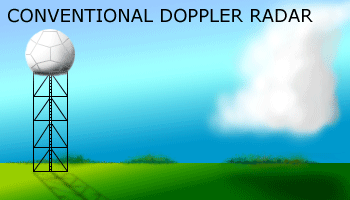Polarimetric Doppler Radar
HOW DO POLARIMETRIC RADARS WORK?
Radars send out short bursts of radio waves called pulses. The pulses bounce off particles in the atmosphere and the energy is reflected back to the radar dish. A computer processes the returned signals and, through algorithms, can make conclusions about what kinds of particles it "saw," including the directions they are moving (the Doppler effect), and the speed of their movement. The WSR-88D radar transmits horizontal pulses, which give a measure of the horizontal dimension of the cloud (cloud water and cloud ice) and precipitation (snow, ice pellets, hail and rain particles).
 Polarimetric radars,
also called dual-polarization radars, transmit radio wave pulses that have
both horizontal and vertical orientations. The additional information from
vertical pulses will greatly improve many different types of forecasts and
warnings for hazardous weather. NSSL's KOUN research radar also has the ability
to transmit the horizontal and vertical pulses at the same time, using a
"simultaneous transmission scheme," (most
research polarimetric radars use an alternate horizontal/vertical transmission
scheme). This reduces the time it takes to scan an area.
Polarimetric radars,
also called dual-polarization radars, transmit radio wave pulses that have
both horizontal and vertical orientations. The additional information from
vertical pulses will greatly improve many different types of forecasts and
warnings for hazardous weather. NSSL's KOUN research radar also has the ability
to transmit the horizontal and vertical pulses at the same time, using a
"simultaneous transmission scheme," (most
research polarimetric radars use an alternate horizontal/vertical transmission
scheme). This reduces the time it takes to scan an area.
WHAT VARIABLES ARE MEASURED?
- Differential Reflectivity – The differential reflectivity is a ratio of the reflected horizontal and vertical power returns. Among other things, it is a good indicator of drop shape. In turn the shape is a good estimate of average drop size.
- Correlation Coefficient – A statistical correlation between the reflected horizontal and vertical power returns. It is a good indicator of regions where there is a mixture of precipitation types, such as rain and snow.
- Linear Depolarization Ratio – This is a ratio of a vertical power return from a horizontal pulse or a horizontal power return from a vertical pulse. It, too, is a good indicator of regions where mixtures of precipitation types occur.
- Specific Differential Phase – The specific differential phase is a comparison of the returned phase difference between the horizontal and vertical pulses. This phase difference is caused by the difference in the number of wave cycles (or wavelengths) along the propagation path for horizontal and vertically polarized waves. It should not be confused with the Doppler frequency shift, which is caused by the motion of the cloud and precipitation particles. Unlike the differential reflectivity, correlation coefficient and linear depolarization ratio, which are all dependent on reflected power, the specific differential phase is a "propagation effect." It is a very good estimator of rain rate.
- Cross-polar terms – other variables yet to be explored!
THE BENEFITS OF POLARIMETRIC RADAR
NSSL conducted the Joint Polarization Experiment (JPOLE) in 2002-2003 to demonstrate the operational capabilities of the polarimetric KOUN. During JPOLE, data were delivered in "real-time" to the NWS and other users. NSSL scientists aided in the data interpretation. JPOLE proved that significant improvements in rainfall estimation, precipitation classification, data quality and weather hazard detection were possible using polarized radar. The impacts of polarimetric radar could be as significant as the nationwide upgrade to Doppler radar in the 1980's, providing measurable benefits to...
Meteorologists:
- Polarimetric radar can significantly improve the accuracy of the estimates of amounts of precipitation
- Polarimetric radar can tell the difference between very heavy rain and hail, which will improve flash flood watches and warnings
- Polarimetric radar can identify types of precipitation in winter weather forecasts, improving forecasts of liquid water equivalent or snow depth
- Polarimetric radar data is more accurate than conventional radar, saving the forecasters the step of having to verify radar data
- Increased confidence in polarimetric radar data can contribute to increased lead time in flash flood and winter weather hazard warnings.
Hydrologists:
- Polarimetric radar provides critical rainfall estimation information for stream flow forecasts and river flooding
- Polarimetric radar could be useful in water management
Aviation users:
- Polarimetric radar detects aviation hazards such as birds
- Polarimetric radar can detect aircraft icing conditions
Society:
- Polarimetric radar has the potential to save the public $690,000,000 annually by improving precipitation estimation
- Polarimetric radar can improve forecasts and warnings and reduce the impact of hazardous weather on our national transportation
- Polarimetric radar better equips forecasters to issue accurate warnings and in turn helps the public make wiser decisions about our safety
